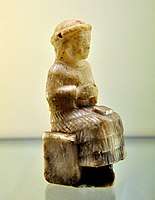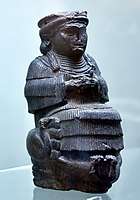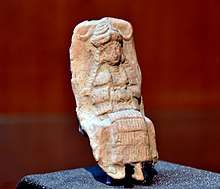Nintinugga
Nintinugga was a Babylonian goddess of healing, the consort of Ninurta. She is identical with the goddess of Akkadian mythology, known as Bau (cuneiform: 𒀭𒁀𒌑 Dba-u2), or Baba though it would seem that the two were originally independent. She is later known as Gula and in medical incantations, Bēlet or Balāti, also as the Azugallatu the "great healer", the same as her son Damu. Other names borne by this goddess are Nin-Karrak, Nin Ezen, Ga-tum-dug and Nm-din-dug. Her epithets are "great healer of the land" and "great healer of the black-headed ones", a "herb grower", "the lady who makes the broken up whole again", and "creates life in the land", making her a vegetation/fertility goddess endowed with regenerative power.[1] She was the daughter of An and a wife of Ninurta. She had seven daughters, including Hegir-Nuna (Gangir).

The name Bau is more common in the oldest period and gives way to Gula after the First Babylonian dynasty. Since it is probable that Ninib has absorbed the cults of minor sun-deities, the two names may represent consorts of different gods. However this may be, the qualities of both are alike, and the two occur as synonymous designations of Ninib's female consort.
She was known as a patron deity of Lagash, where Gudea built her a temple.
After the Great Flood, she helped "breathe life" back into mankind. The designation well emphasizes the chief trait of Bau-Gula which is that of healer. She is often spoken of as "the great physician," and accordingly plays a specially prominent role in incantations and incantation rituals intended to relieve those suffering from disease.
She is, however, also invoked to curse those who trample upon the rights of rulers or those who do wrong with poisonous potions. As in the case of Ninib, the cult of Bau-Gula was prominent in Shirgulla and in Nippur. While generally in close association with her consort, she was also invoked alone, giving her more dominance than most of the goddesses of Babylonia and Assyria.
In the Neo-Babylonian period, she also had an oneiric quality. She had sometimes violent nature as the "queen whose 'tempest', like a raging storm, makes heaven tremble, makes earth quake".[2]). She was a source for blasphemous remarks where Gula and her dogs are mentioned in formulae of a curse.[3]
She appears in a prominent position on the designs accompanying the Kudurrus boundary-stone monuments of Babylonia, being represented by a portrait, when other gods and goddesses are merely pictured by their shrines, by sacred animals or by weapons. In neo-Babylonian days her cult continues to occupy a prominent position, and Nebuchadrezzar II speaks of no less than three chapels or shrines within the sacred precincts of E-Zida in the city of Borsippa, besides a temple in her honour at Babylon.
Gallery
 Bust of a goddess, perhaps Bau, wearing horned cap. Limestone, Neo-Sumerian period (2150-2100 BC). From Telloh, ancient Girsu, Musée du Louvre
Bust of a goddess, perhaps Bau, wearing horned cap. Limestone, Neo-Sumerian period (2150-2100 BC). From Telloh, ancient Girsu, Musée du Louvre Goddess Nintinugga (Bau), sitting on a stool, c. 2000 BC, from Southern Iraq, Pergamon Museum, Germany
Goddess Nintinugga (Bau), sitting on a stool, c. 2000 BC, from Southern Iraq, Pergamon Museum, Germany Goddess Nintinugga (Bau) from Ur, Isin-Larsa period, c. 1800 BC. Iraq Museum, Baghdad
Goddess Nintinugga (Bau) from Ur, Isin-Larsa period, c. 1800 BC. Iraq Museum, Baghdad Mesopotamian female deity seating on a chair, probably Ishtar or Bau, 2003-1595 BC, from Ur, Sulaymaniyah Museum, Iraq
Mesopotamian female deity seating on a chair, probably Ishtar or Bau, 2003-1595 BC, from Ur, Sulaymaniyah Museum, Iraq
References

- Michael Jordan, Encyclopedia of Gods, Kyle Cathie Limited, 2002.
- BAU: "An adab to Bau for Luma." and "A tigi to Bau for Gudea (Gudea A)". Sumerian royal praise poetry before the Third Dynasty of Ur. See: The Electronic Text Corpus of Sumerian Literature.
- Specific
External links


- "Going to the Dogs": Healing Goddesses of Mesopotamia
- Ancient Mesopotamian Gods and Goddesses: Baba (goddess)